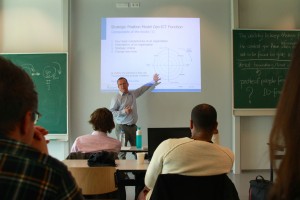Advanced Methods and Techniques for Geo-data Handling
This course continues where Module 1 left off. It addresses more than Module 1 on the processes behind GI. The course will be followed by the application of the contents in Module 6.
Themes
- Spatial analysis
- Geodata models
- Geodatabases
- Python programming
- Spatialtemporal modelling
- 3D modelling
- Web-based geodata dissemination
Course objectives
The student will be able to:
- Have an overview of simple and advanced spatial data models and understand which model serves which purpose
- Be proficient in elementary (query) spatial data operators, in both raster and vector domain
- Understand and be able to set up and carry out spatial computations
- Understand the principles of spatiotemporal modelling in GIS
- Understand, and to some extend apply, the principles of spatial planning support
- Understand how geodata can be made public using visualization technology developed for the internet
- Have specialized themselves in one of the offered in-depth study topics
Content
Two phases: a breadth-first phase, and an in-depth phase.
The breadth-first phase covers in principle six topic assignments:
- Spatial analysis
- Simple and advanced geodata models
- Geodatabases and their design and use
- Python programming
- Spatial-temporal modelling
- Web-based geodata dissemination
The in-depth phase will build on one of the breadth-first topics.
Type of education
This distance learning module will include:
- Lectures
- Distance learning
- Academic reviewing
- Literature study
- Individual assignments
- Case study (in-depth analysis)
- Reporting
- Presentation
- Evaluation
Assessment
- Written examination and exercises (on breadth-first topics)
- Written report and presentation (on in-depth topic)
Literature
Reader with background information for breadth-first topics
Entry requirements
Letter of acceptance of the master programme Geographical Information Management and Applications and passed Module 1.



